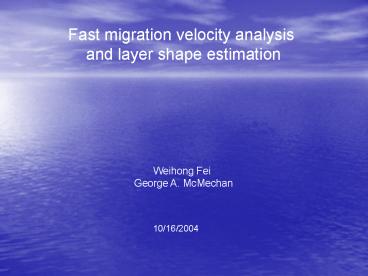Fast migration velocity analysis PowerPoint PPT Presentation
1 / 22
Title: Fast migration velocity analysis
1
Fast migration velocity analysis and layer shape
estimation
Weihong Fei George A. McMechan
10/16/2004
2
Outline
- Introduction
- Methodology of the proposed algorithm
- Examples
- Advantages and disadvantages of the algorithm
- Conclusions
3
Introduction
Conventional Normal Moveout (NMO) velocity
analysis cant provide a good velocity model
because of the inherent assumptions
1. Lateral homogeneity 2. Small offset 3. Flat
layers
There may be significant errors when RMS velocity
is converted into interval velocity using Dixs
formula when the assumptions are not satisfied.
4
- Migration velocity analysis
Pre-stack migration
Different algorithms differ in how to update the
velocity on the basis of the residual curvature
in the CIG
5
The best migration velocity analysis methods
involve iterative prestack depth migration. This
is inefficient in computation time.
Conventional prestack migration of all traces ?
sort into CIGs Proposed preselect CRP
traces, and only process those.
6
Methodology of the proposed algorithm
This algorithm is a macro-model-based layer
stripping method
Step 1 Incident angle estimation and zero-offset
migration.
Step 2 Definition and extraction of common
reflection point (CRP) gathers by ray tracing.
Step 3 Perturbation to update the initial
velocity and reflector position.
7
Step 1 Incident angle estimation and zero-offset
migration
8
After estimating the p values, and given an
initial velocity model, we calculate the starting
angles using psin(?)/v. Then, we get reflection
points (x, z, dip) information by a
parsimonious post-stack migration (Hua and
McMechan, 2001).
9
Step 2 Define and extract (CRP) gathers through
ray tracing.
- Two-point ray tracing is used for the ray path
from Si to p1i - Shooting rat tracing is used for ray path from
to surface - receiver location
Position
Offset
s2
r2
s1
r1
sn
rn
p1i
?
Depth
Time
a
b
When velocity is in error, T and T will be
different. Next, we adjust the velocity model to
make T and T trajectories as close as possible.
10
Step 3 Velocity Perturbation
sj
rj
s0, r0
tsj
trj
?
(p1i, v0)
Next, we will change the traveltime
proportionally to the velocity change using
Having finished the traveltime update for one
source-receiver pair, repeat for all the other
source-receiver pairs at the same reflection
point.
11
- A new set of traveltime is obtained after
velocity perturbation from V0 to V1
- Sum the amplitude along the new traveltime
trajectory
- Repeat velocity perturbation and amplitude
summation
- The velocity corresponding to the maximum stacked
amplitude will be - the estimated local velocity for this layer
- Repeat the process for all other reflection points
- Proceed to the next layer after the current layer
is converged
12
Velocity perturbation illustration
Offset
Time
True traveltime trajectory
Estimated v, z
stack amplitude
0
This process is closely related to both NMO
velocity analysis and prestack migration velocity
analysis. However, we do not have the assumptions
associated with NMO, and we get interval velocity
instead of RMS velocity.
13
Smoothing and interpolation to define the
reflector shape
p1i
?
Proceed to the next layer
14
Examples
- Model 1 (for constant velocity layer)
3.7 km/s
(a) True velocity model
(b) Estimated velocity model
(c) Velocity model from NMO method
Initial velocity is a constant with 1.8 km/s, for
each layer, two iterations are enough to reach
convergence. For each iteration, averagely only
32 seconds is needed.
15
- Model 2 (lateral velocity gradients)
(a) True velocity model
(b) Estimated velocity model
(c) Velocity model from NMO method
Initial constant velocity is 3.0 km/s everywhere
16
- Model 3 (salt velocity model)
Correct velocity
Estimated velocity
Initial velocity with 1.8km/s everywhere
17
CIGs at the 1,2 and 3 postions (previous slide)
using estimated velocity model
18
Field data test
Stacked section of the North Sea 2-D field data
Eight reflection events are picked
19
Initial velocity is constant with 1.5 km/s
everywhere
Estimated velocity
NMO velocity
20
CIGs at A and B points (previous slide)
CIGs using initial velocity
CIGs using estimated veloctiy
21
Advantages and disadvantages
- Advantages
- Fast minimizes ray tracing and prestack depth
migration computations - Accurate, usually two iterations can give a good
result - Using straight ray paths within layers saves
computation time - Based on a constant local velocity assumption,
we can detect lateral - velocity variations
- Disadvantages
- Noise level may influence the result
- The quality of stacked section
- The difference between the initial input
velocities and correct velocities
22
Conclusions
- A very fast and accurate velocity analysis
algorithm is developed - Computation time is 2-3 orders of magnitude
faster than the iterative prestack depth
migration velocity analysis method - Can efficiently handle lateral velocity
variations, as well as constant velocity

